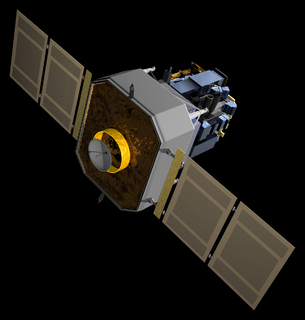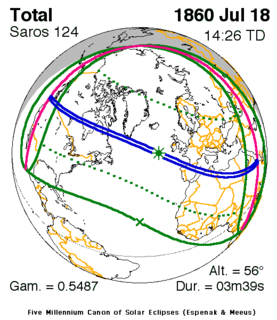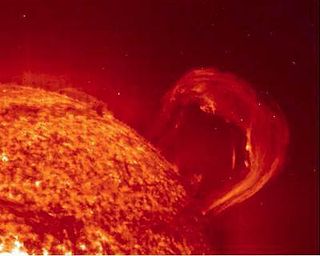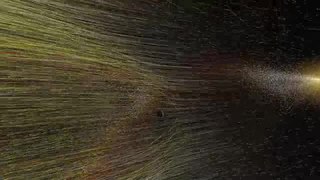
The solar wind is a stream of charged particles released from the upper atmosphere of the Sun, called the corona. This plasma consists of mostly electrons, protons and alpha particles with kinetic energy between 0.5 and 10 keV. Embedded within the solar-wind plasma is the interplanetary magnetic field. The solar wind varies in density, temperature and speed over time and over solar latitude and longitude. Its particles can escape the Sun's gravity because of their high energy resulting from the high temperature of the corona, which in turn is a result of the coronal magnetic field.

A solar flare is a sudden flash of increased brightness on the Sun, usually observed near its surface and in close proximity to a sunspot group. Powerful flares are often, but not always, accompanied by a coronal mass ejection. Even the most powerful flares are barely detectable in the total solar irradiance.

The Solar and Heliospheric Observatory (SOHO) is a spacecraft built by a European industrial consortium led by Matra Marconi Space that was launched on a Lockheed Martin Atlas II AS launch vehicle on December 2, 1995 to study the Sun. SOHO has also discovered over 3,000 comets. It began normal operations in May 1996. It is a joint project of international cooperation between the European Space Agency (ESA) and NASA. Originally planned as a two-year mission, SOHO continues to operate after over 20 years in space: the mission is extended until the end of 2020 with a likely extension until 2022.
A solar storm is a disturbance on the Sun, which can emanate outward across the heliosphere, affecting the entire Solar System, including Earth and its magnetosphere, and is the cause of space weather in the short-term with long-term patterns comprising space climate.
Coronal holes are areas where the Sun's corona is colder, hence darker, and has lower-density plasma than average because there is lower energy and gas levels. Coronal holes are part of the Sun's corona and are constantly changing and reshaping because the corona is not uniform. The Sun contains magnetic fields that arch away from areas in the corona that are very thin due to the lower levels of energy and gas, which cause coronal holes to appear when they do not fall back. Thus, solar particles escape at a rate great enough to create a lower density and lower temperature in that area.

A Moreton wave or Moreton-Ramsey wave is the chromospheric signature of a large-scale solar coronal shock wave. Described as a kind of solar "tsunami", they are generated by solar flares. They are named for American astronomer Gail Moreton, an observer at the Lockheed Solar Observatory in Burbank, and Harry E. Ramsey, an observer who spotted them in 1959 at The Sacramento Peak Observatory. He discovered them in time-lapse photography of the chromosphere in the light of the Balmer alpha transition.
Comet C/2002 V1 (NEAT) is a non-periodic comet that appeared in November 2002. The comet peaked with an apparent magnitude of approximately –0.5, making it the eighth-brightest comet seen since 1935. It was seen by SOHO in February 2003. At perihelion the comet was only 0.099258 astronomical units from the Sun.
A magnetic cloud is a transient event observed in the solar wind. It was defined in 1981 by Burlaga et al. 1981 as a region of enhanced magnetic field strength, smooth rotation of the magnetic field vector, and low proton temperature. Magnetic clouds are a possible manifestation of a coronal mass ejection (CME). The association between CMEs and magnetic clouds was made by Burlaga et al. in 1982 when a magnetic cloud was observed by Helios-1 two days after being observed by SMM. However, because observations near Earth are usually done by a single spacecraft, many CMEs are not seen as being associated with magnetic clouds. The typical structure observed for a fast CME by a satellite such as ACE is a fast-mode shock wave followed by a dense sheath of plasma and a magnetic cloud.
The "Sun Watcher using Active Pixel System Detector and Image Processing" (SWAP) telescope is a compact EUV imager on board the PROBA2 mission that will observe the Sun in extreme ultraviolet (EUV). SWAP will provide images of the solar corona at a temperature of roughly 1 million degrees. This instrument was built upon the heritage of the Extreme ultraviolet Imaging Telescope (EIT) which monitors the solar corona since 1996.

Aditya or Aditya-L1 is a spacecraft whose mission is to study the Sun. It was conceptualised by the Advisory Committee for Space Research in January 2008. It has been designed and will be built in collaboration between Indian Space Research Organisation (ISRO) and various Indian research organizations and will be launched by ISRO around 2021.

The Sagamore Hill Solar Radio Observatory is a solar radio observatory located in Hamilton, Massachusetts, that operates on a daily basis to obtain scientific observations of the Sun. It is a functional component of the Radio Solar Telescope Network (RSTN).
The Radio Solar Telescope Network (RSTN) is a network of solar observatories maintained and operated by the 557th Weather Wing, ACC. The RSTN consists of ground-based observatories in Australia, Italy, Massachusetts, New Mexico and Hawaii.

A total solar eclipse occurred on July 18, 1860. A solar eclipse occurs when the Moon passes between Earth and the Sun, thereby totally or partly obscuring the image of the Sun for a viewer on Earth. A total solar eclipse occurs when the Moon's apparent diameter is larger than the Sun's, blocking all direct sunlight, turning day into darkness. Totality occurs in a narrow path across Earth's surface, with the partial solar eclipse visible over a surrounding region thousands of kilometres wide.
People watching an eclipse in 1860 at Toulouse, France. Picture by Eugène Trutat, Muséum de Toulouse.

A coronal cloud is the cloud of hot plasma gas surrounding a coronal mass ejection. It is usually made up of protons and electrons. When a coronal mass ejection occurs at the Earth's Sun, it is the coronal cloud that usually reaches Earth and causes damage to electrical equipment and space satellites, not the ejection or flare itself. The damage is mostly the result of the high amount of electricity moving through the atmosphere.

Solar phenomena are the natural phenomena occurring within the magnetically heated outer atmospheres in the Sun. These phenomena take many forms, including solar wind, radio wave flux, energy bursts such as solar flares, coronal mass ejection or solar eruptions, coronal heating and sunspots.
Barbara J Thompson is an American solar physicist. She is a scientist working as a civil servant at NASA's Goddard Space Flight Center. She is noted for wide-ranging contributions to the study of eruptive phenomena in the solar corona, beginning with the Solar and Heliospheric Observatory mission in the 1990s. Early work included EUV imaging studies of coronal mass ejections (CMEs) and their aftermath, including discovery of a global coronal wave response to the launch of CMEs. She was a major organizer of the global International Heliophysical Year effort to study external drivers of planetary environments . Thompson was the project scientist for NASA's Solar Dynamics Observatory mission through development and early flight, and continues to hold a major role in that mission, while conducting ongoing research into CME onset and propagation.

Supra-arcade downflows (SADs) are sunward-traveling plasma voids that are sometimes observed in the Sun's outer atmosphere, or corona, during solar flares. In solar physics, an “arcade” refers to a bundle of coronal loops, and the prefix “supra” indicates that the downflows appear above flare arcades. They were first described in 1999 using the Soft X-ray Telescope (SXT) on board the Yohkoh satellite. SADs are byproducts of the magnetic reconnection process that drives solar flares, but their precise cause remains unknown.
Lagrange is a 2018 concept study for a solar weather mission by the European Space Agency (ESA). This is a British-led concept that envisions two spacecraft to be positioned at Lagrangian points L1 and L5.













